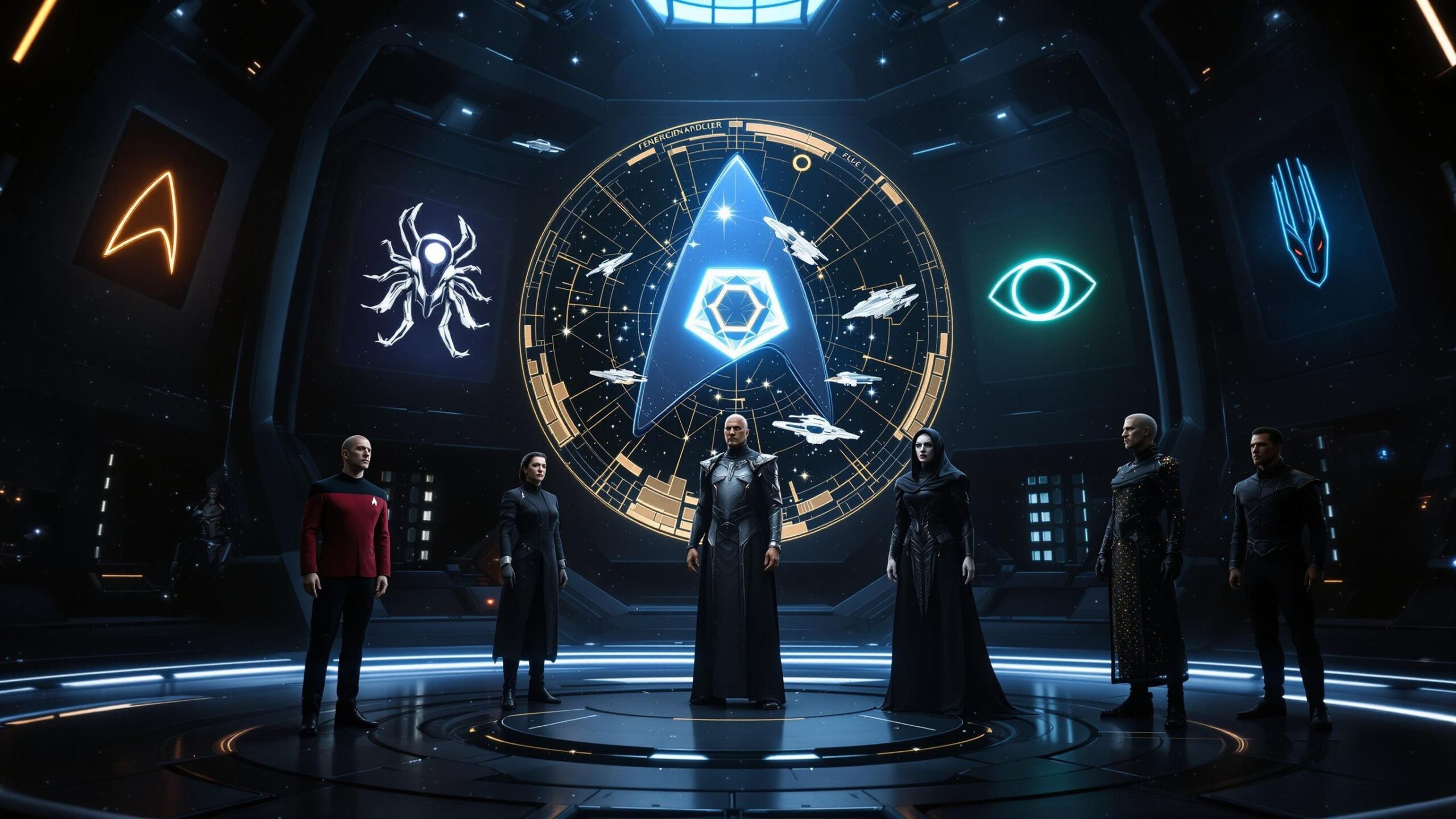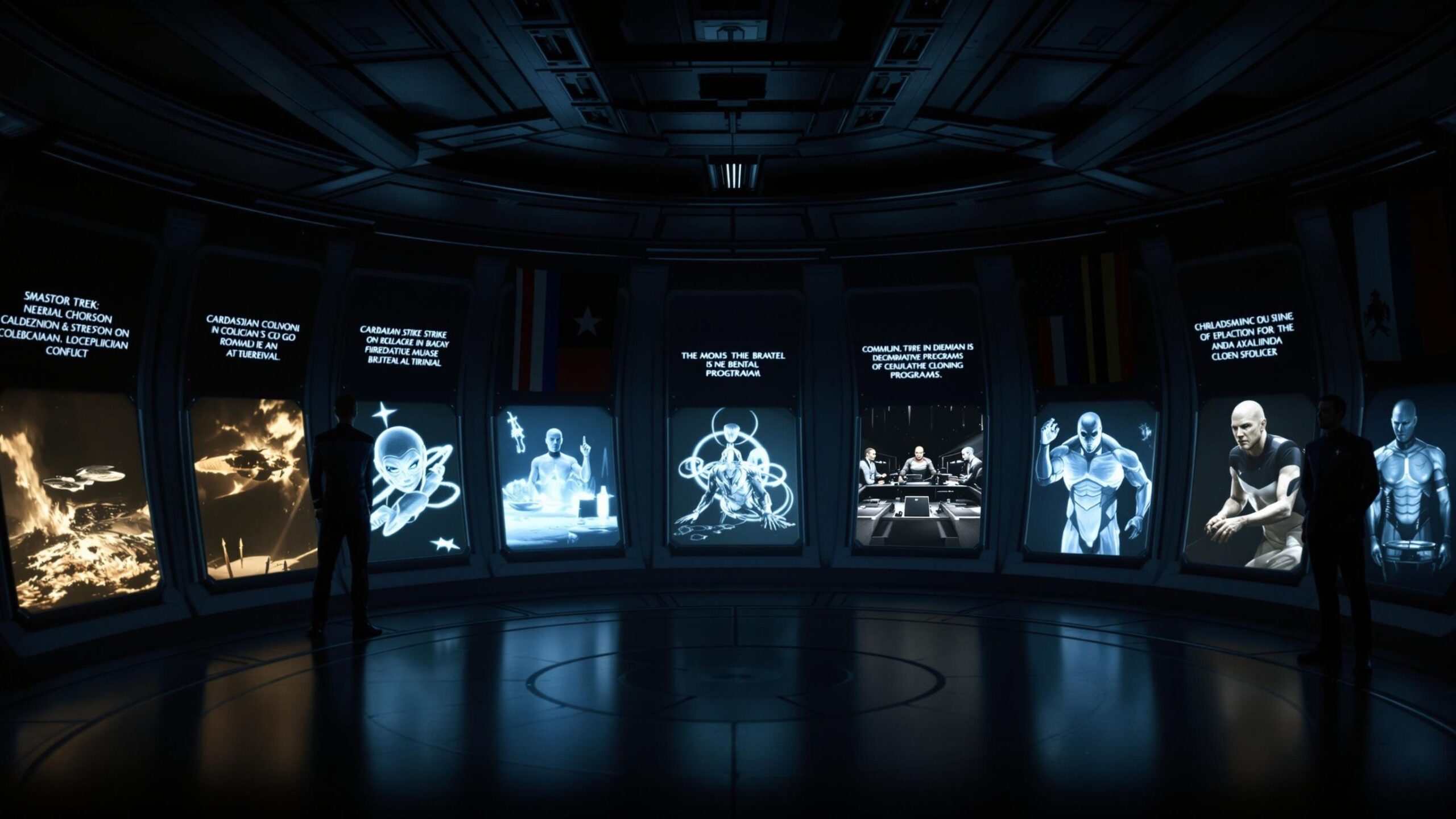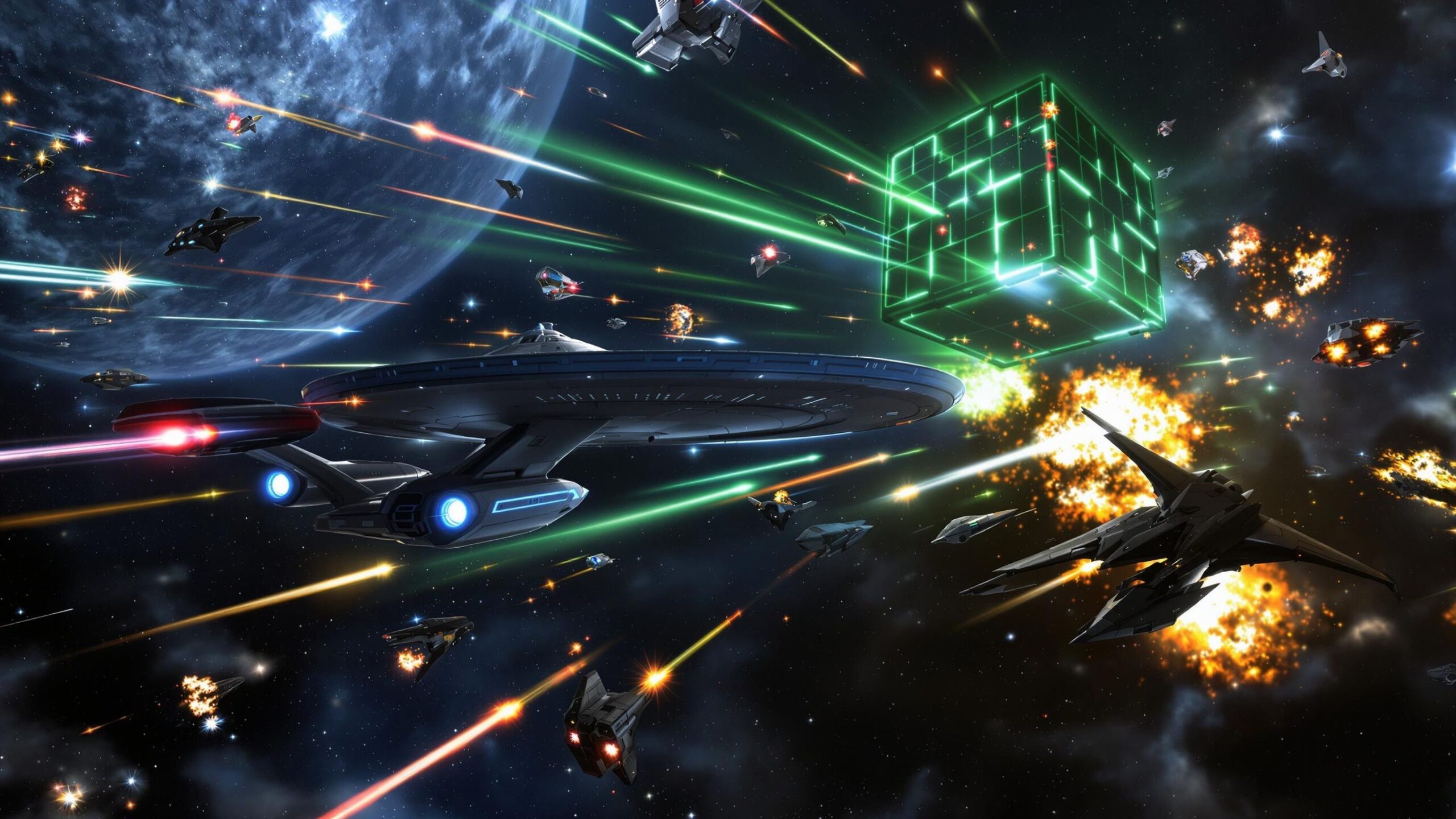The Star Trek universe is filled with ambitious civilizations vying for control, influence, and survival in a galaxy rich with resources, political intrigue, and ancient secrets. While Starfleet and the United Federation of Planets are the moral compass of the franchise, they’re far from the only major galactic power. From expansionist militaries to secretive ancient species, the empires of Star Trek represent a range of ideologies—each with their own strengths, flaws, and legacies. Their influence spans entire quadrants, and their conflicts have shaped centuries of cosmic history. These are the Top 10 Most Powerful Empires in Star Trek, ranked not only by military might, but also by political influence, cultural dominance, and sheer fear factor.
#10: The Breen Confederacy
The Breen were long considered enigmatic and relatively neutral, but their sudden alliance with the Dominion during the Dominion War revealed their true capabilities. Wearing fully enclosed refrigeration suits, their physiology remains one of the great mysteries of the Alpha Quadrant. The Breen Confederacy shocked the galaxy with the use of powerful energy-dampening weapons—technology capable of rendering entire fleets helpless, including the USS Defiant. Their bold attack on Starfleet Headquarters on Earth sent political shockwaves across the quadrant, proving they could strike even the Federation’s heart. The Breen’s elusive nature, combined with their advanced tech and military surprise, cemented them as a terrifying wildcard. Their motivations remain obscure, which only adds to their mystique—and the fear they instill.
#9: The Orion Syndicate
While not an empire in the traditional territorial sense, the Orion Syndicate operates as a powerful criminal shadow empire, stretching across countless worlds and thriving within both neutral zones and Federation territory. Known for their manipulation, bribery, slavery, and piracy, the Syndicate’s true power lies in its invisibility and influence. They control trade routes, sabotage diplomatic talks, and even infiltrate high-ranking political structures. Their ability to corrupt law enforcement and manipulate economies makes them a subtle but potent force. Starfleet officers like O’Brien have nearly lost their lives infiltrating this organization, and even the Klingons and Romulans tread carefully when dealing with them. The Orions remind us that power doesn’t always fly starships—it sometimes whispers through bribes and black markets.
#8: The Gorn Hegemony
The Gorn may be best remembered for their slow, lizard-like duel with Captain Kirk in “Arena,” but modern Star Trek—especially Strange New Worlds—has re-established them as one of the most terrifying and tactically brutal powers in the galaxy. The Gorn are xenophobic, territorial, and use biologically horrifying reproductive tactics. Their hatchlings are known to violently burst from host bodies and kill each other until only the strongest survive. In Strange New Worlds, even Starfleet captains consider a single Gorn ship a catastrophic threat. Their warships, cloaking capabilities, and survival instincts rival the more technologically sophisticated empires. The Gorn Hegemony values strength above all, and their society is shaped by ruthless Darwinism. They may not negotiate, but they certainly conquer.
#7: The Tholian Assembly
The Tholians are mysterious, crystalline beings with extreme territoriality and incredibly advanced energy-based technology. While communication with them is notoriously difficult, their spatial manipulation abilities—such as the Tholian Web—represent some of the most unique and potent weapons in the galaxy. Their ships can emit spatial energy traps that immobilize targets, and they are capable of operating in regions of space that destroy other vessels. Tholians also have time-manipulation capabilities, as seen in Enterprise, where they attempt to salvage technology from alternate timelines. While not expansionist in the traditional sense, the Tholian Assembly commands absolute control within its borders. Their precision, lack of diplomacy, and lethal response to intrusion make them a quiet but formidable galactic power.
#6: The United Federation of Planets
While the Federation is the philosophical and moral heart of Star Trek, its power cannot be underestimated. With a combination of economic cooperation, shared scientific knowledge, and defense via Starfleet, the Federation maintains stability across hundreds of member worlds. Its diplomatic reach and soft power are unmatched nations like the Klingons and Romulans have alternately fought and allied with it, acknowledging its influence. Starfleet’s technological innovations—warp drive, replicators, quantum torpedoes—are cutting-edge, and its crews are among the best trained. However, its strength also lies in its ability to form coalitions, such as during the Dominion War, when it led the alliance against one of the most dangerous threats in the quadrant. The Federation’s challenge has always been balancing peacekeeping with defense—but its resilience, adaptability, and ideals have kept it powerful for centuries.
#5: The Romulan Star Empire
Cloaked in secrecy and driven by ruthless pragmatism, the Romulan Star Empire is one of the most feared powers in the galaxy. Masters of espionage, subterfuge, and manipulation, the Romulans have frequently destabilized their rivals through intelligence networks like the Tal Shiar. Their military, while not as massive as the Dominion or Federation, is highly advanced—especially their cloaking technology and singularity-powered warbirds. Politically, the Romulans play the long game, often pitting other empires against each other while protecting their own interests. The destruction of Romulus in the 24th century (Star Trek: Picard) weakened their centralized power but fractured the empire into numerous dangerous splinters. Even fragmented, Romulans remain power players, thanks to their culture of secrecy, intelligence, and sheer will.
#4: The Klingon Empire
Fierce, honor-bound, and deeply hierarchical, the Klingon Empire has endured for centuries through military strength and cultural resilience. While often portrayed as a warrior race, the Klingons are also skilled tacticians, political operators, and masters of fearsome warship design. Their Bird-of-Prey and Negh’Var-class battleships are built for direct combat, cloaking, and planetary assaults. Unlike the Romulans, Klingons do not rely on subterfuge—they revel in open confrontation, and their military doctrine emphasizes glorious death and decisive strikes. The Empire has waged war with nearly every major galactic power, including the Federation, and even briefly conquered sectors of the Cardassian Union. Klingon power stems not just from raw military force, but also from their cultural unity. Even in political disarray, Klingons rally around the banner of honor and conquest. Their influence has waxed and waned, but the Empire remains an ever-present superpower capable of turning the tide of any interstellar conflict.
#3: The Cardassian Union (especially during the Dominion Alliance)
The Cardassian Union was already a formidable power in its own right before allying with the Dominion. Built on authoritarianism, surveillance, and militaristic expansion, the Cardassians maintained strict control over their territory and subjugated entire worlds—most infamously Bajor. Their Obsidian Order was one of the most feared intelligence agencies in the quadrant, capable of manipulating foreign governments and silencing internal dissent with terrifying efficiency. During their alliance with the Dominion, Cardassian power surged. Backed by Jem’Hadar forces and Dominion technology, they nearly conquered the Alpha Quadrant. Cardassia became a central hub for war logistics, intelligence, and industrial production. Though they would ultimately betray the Dominion and suffer near-annihilation as punishment, their combined strength during the war solidified them as one of the most dangerous powers Star Trek has ever portrayed. Cold, calculating, and morally complex, the Cardassian Union remains synonymous with brutal, efficient empire-building.
#2: The Dominion
Emerging from the Gamma Quadrant with a vast army of genetically engineered warriors, the Dominion was a game-changer for interstellar politics. Ruled by the shapeshifting Founders, who enforced order through the ruthless Vorta administrators and the deadly Jem’Hadar soldiers, the Dominion’s strength lay in its absolute hierarchy and militarized efficiency. Unlike other empires, which relied on negotiation or diplomacy, the Dominion expanded through conquest, biological control (e.g., addiction to Ketracel-white), and fear. Their military tactics overwhelmed entire fleets, and their willingness to genetically engineer obedient populations made them unstoppable—until unified resistance from the Federation, Klingons, and Romulans turned the tide. Even then, it took years of war, immense sacrifice, and inside resistance to finally defeat them. The Dominion represented a terrifying idea: control through perfection, order through fear, and a willingness to exterminate entire civilizations to preserve stability. Their legacy still haunts the Alpha Quadrant.
#1: The Borg Collective
Without question, the Borg Collective is the most terrifying and powerful empire in Star Trek history. The Borg aren’t a political body—they are a force of nature. With no interest in diplomacy, territory, or ideology, the Borg seek only one thing: assimilation. Their power lies in their sheer inevitability. Every ship, species, and technology they encounter is absorbed into their hive mind. Their cube-shaped vessels are nearly indestructible, capable of annihilating entire fleets with minimal damage. Starfleet’s greatest captains—Picard, Janeway, Sisko—have faced them, and barely escaped. The battle at Wolf 359 left 39 ships destroyed. The Voyager crew, stranded in the Delta Quadrant, spent years avoiding and occasionally allying with Borg factions just to survive. Unlike other empires, the Borg do not negotiate. Their chilling mantra—“Resistance is futile”—speaks to their unstoppable nature. Even time itself has been manipulated by the Borg, who attempted to prevent First Contact in a bid to rewrite history. No other power strikes as much existential dread into the hearts of Star Trek fans and characters alike.
The empires of Star Trek are more than just military juggernauts or political entities—they’re reflections of ideologies, cultural identities, and the extremes of power. Whether through brute strength, covert influence, or relentless assimilation, each of these civilizations has shaped galactic history in profound ways. They challenge the Federation’s ideals, test the morality of its officers, and serve as mirrors of real-world ambition and ideology. In a galaxy of warp drives and wormholes, it’s not just who has the most firepower—but who commands the hearts, minds, and fears of the stars.




